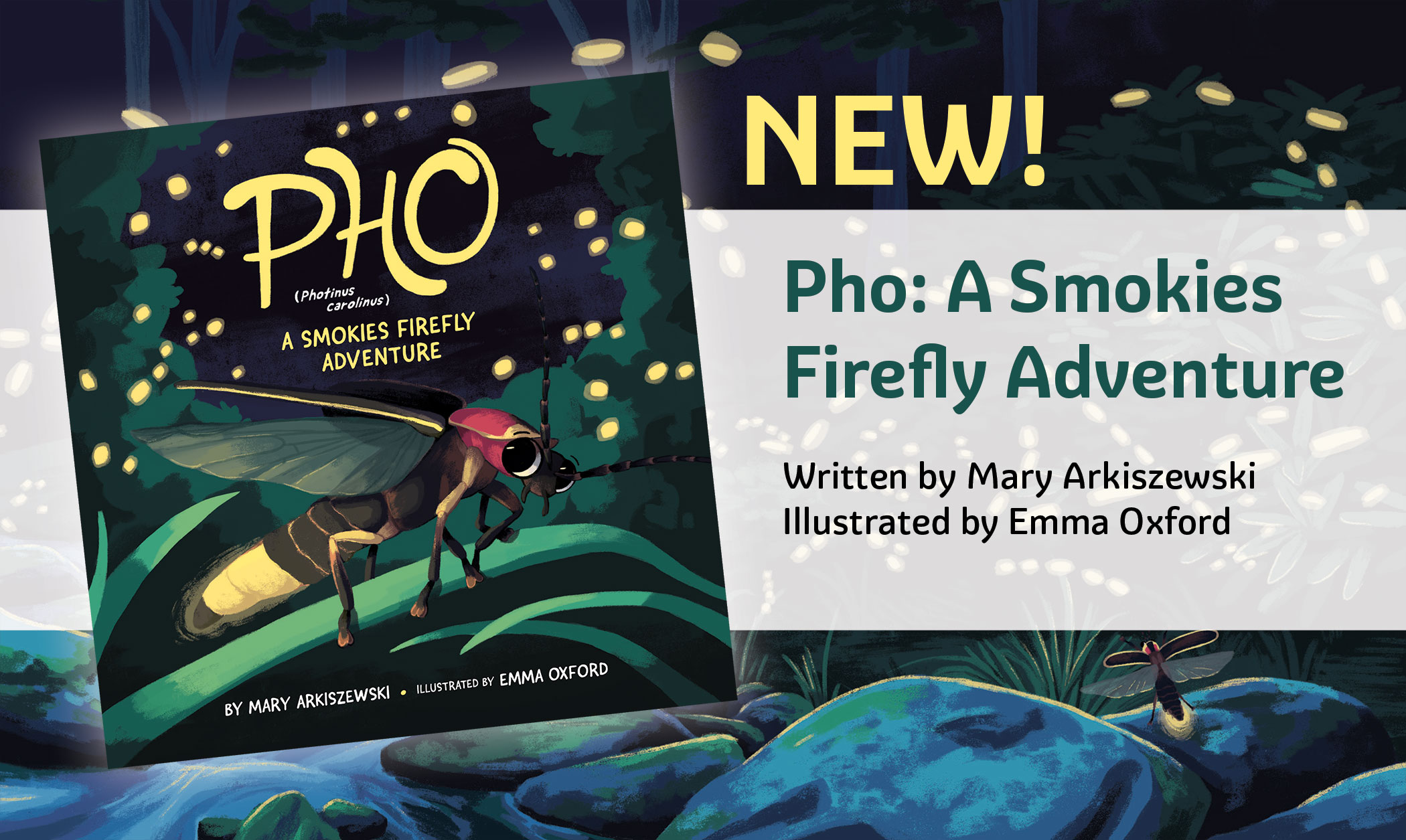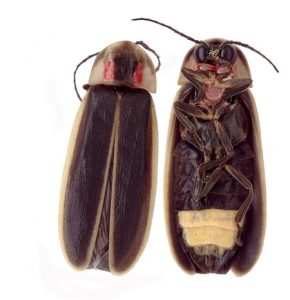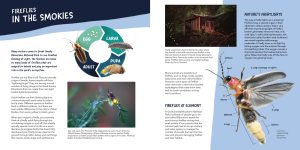
Mary Arkiszewski stumbled upon Great Smoky Mountains National Park’s most famous flashing beetle, the synchronous firefly, almost by accident. She and her husband had always enjoyed hiking and exploring the national parks, and when the pandemic lockdowns sideswiped all the regular rhythms of their life in Greensboro, North Carolina, they decided to start camping again. Arkiszewski (pronounced ‘R-kazoo-ski’) read about the synchronous firefly event that takes place each year at Elkmont and immediately made plans to go.

Despite experiencing the show a few days after firefly activity had peaked, it was “quite an amazing spectacle,” she said—and an inspiration.
Arkiszewski, a retired elementary school teacher, had always wanted to write children’s books. Four kids and a career put that dream on hold, but after seeing the fireflies, she knew there was a great story waiting to be told in the dark, flashing forest. Now, that story is on bookstore shelves throughout Great Smoky Mountains National Park—Smokies Life recently released Pho: A Smokies Firefly Adventure, with illustrations from Emma Oxford bringing Arkiszewski’s vision to life.
The book tells the story of a single synchronous firefly named Pho—short for the species’ Latin name, Photinus carolinus—as he sets out to find a mate on a Smokies summer night. Pho must endure danger from multiple would-be predators and copy the code flashed by a forest full of other male fireflies to find his perfect match, ensuring that the dance of the fireflies continues for many summers to come.
Synchronous fireflies are so named for their impressive mating display, typically occurring between late May and mid-June each year. Starting half an hour after sunset and lasting through about midnight, in unison the males emit five to 11 flashes of yellow light, followed by six to nine seconds of darkness. It makes for a magical spectacle, like a woodland display of blinking Christmas lights. The experience has become so popular among park visitors that a lottery system was instituted to prevent trampling and overcrowding at Elkmont, site of the most vibrant display. While by far the most well-known of the Smokies’ flashing bugs, synchronous fireflies are just one of 19 firefly species—13 of which flash—known to be living in the park.

There’s more to writing a children’s book than meets the eye. Every word must serve a purpose, advancing the story and engaging readers while still accurately rendering the science underlying the fictional characters and storyline. But words alone aren’t enough—a quality children’s book needs quality illustrations. Both Arkiszewski and Valerie Polk, the book’s editor and Smokies Life’s publications associate, are enthusiastic when they discuss what Oxford’s artwork added to the story.
“She was able to put it into something visual that I couldn’t even imagine when I read the story initially,” Polk said, praising the individual personalities and expressions with which Oxford imbued Arkiszewski’s characters, and the colorful vividness of the scenes.
Like Arkiszewski, Oxford has been entranced by the fireflies’ ephemeral show since the first time she saw it, in 2017. But when she was offered the chance to illustrate the book, she immediately recognized how challenging the project would be. The book’s main character is an insect, for one thing, and the storyline takes place in the dark of night. Synchronous fireflies are most visually arresting when seen as a group, but this story focused on the saga of one individual insect. Perhaps the “most intimidating” part was deciding how to break Arkiszewski’s story up into separate illustrated pages.
Luckily, Oxford already had experience bringing animal protagonists to life. She was also the illustrator for the 2021 children’s chapter book A Search for Safe Passage by Frances Figart, also published by Smokies Life.

“I just tried to keep it varied in terms of color, and even though it all occurred at night, use storybook illustration techniques to keep it engaging,” she said. “I also tried to make Pho emotive, to show his fear and excitement and despair and elation and all those things that we experience—which is a little on the anthropomorphizing side, but it’s an important way to help kids relate.”
The result of Oxford’s effort is a 32-page book featuring “gorgeous” illustrations that show “exactly what I was thinking in my head” when imagining the story, Arkiszewski said.
Pho is an action-packed story sure to stimulate young imaginations—but it’s intended to educate as well. In addition to designing eye-catching illustrations and hammering down the plot points of Pho’s first night of flight, the team behind the book worked to make it as scientifically accurate as possible.
All of the animal behaviors shown in the book are based on what scientists have seen in the real world, Polk said. Entomologist Will Kuhn, who serves as director of science and research for park partner Discover Life in America, worked closely with the team to ensure that every aspect of the book lined up with current research on the world of synchronous fireflies.
“We’re incredibly grateful to Will Kuhn for his expert guidance,” Polk said. “He helped ensure the story was grounded in science without stifling the creative elements of a children’s book. The way Mary skillfully incorporated Will’s suggestions really elevated the story.”

After adventuring along with Pho, readers arrive at six pages of engaging back matter designed to help parents answer their kids’ questions and go deeper into the scientific foundation for Pho’s adventure. These pages discuss the firefly’s life cycle and anatomy, the different flash patterns the Smokies’ diverse firefly species employ, and how to help protect them through actions like reducing outdoor lighting, leaving dead leaves on the ground, and planting native species.
“As a parent, I know what it’s like to have your kid ask you a hundred questions based on something they read, and I wanted to be able to provide the answers for adults that are reading along with their kids,” Polk said.
She brought in an expert consultant to ensure the book met the mark in that respect—her daughter Emily.

“When we started this book,” said Polk, “my daughter was on the older end of our target age group, so I handed over some materials about fireflies that we had developed and the text of the book and said, ‘Tell me what you don’t understand. Tell me what you think would be great for kids to know.’”
That feedback was a “great help” in tailoring those pages to meet kids’ needs. Polk, Oxford, and Arkiszewski are all thrilled with how the book has turned out and hope Pho’s adventure not only provides ongoing entertainment to young readers but also helps them to recognize the role they can play in helping fireflies like Pho thrive in the wild.
“I think fireflies are kind of like the polar bears of the insect world, in that they’re charismatic and a lot of things you can do to protect fireflies have an impact on the rest of the insect world,” Oxford said. “I hope that people gain a greater appreciation for what insects go through and how we can try to keep not only our national parks but also our yards more preserved as a habitat for these creatures.”
Subscribe to get the latest posts sent to your email.
The Great Smokies Welcome Center is located on U.S. 321 in Townsend, TN, 2 miles from the west entrance to Great Smoky Mountains National Park. Visitors can get information about things to see and do in and around the national park and shop from a wide selection of books, gifts, and other Smokies merchandise. Daily, weekly, and annual parking tags for the national park are also available.